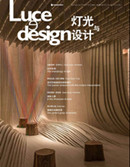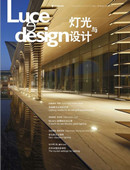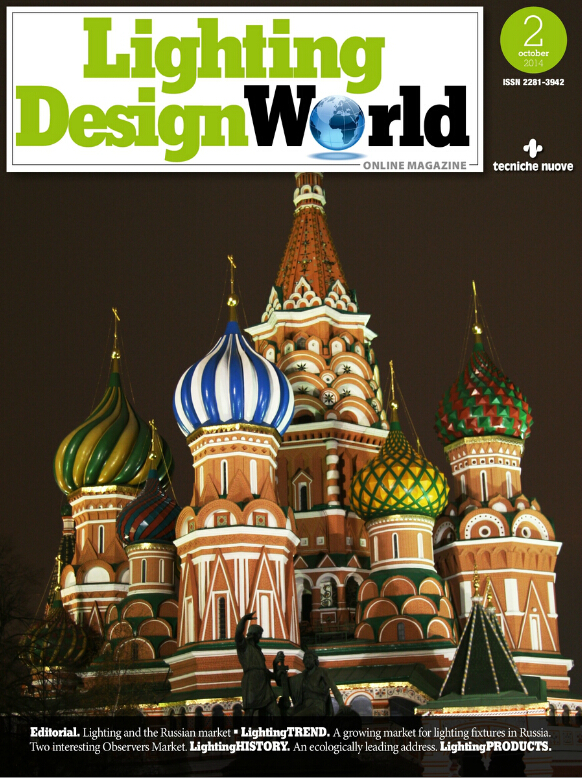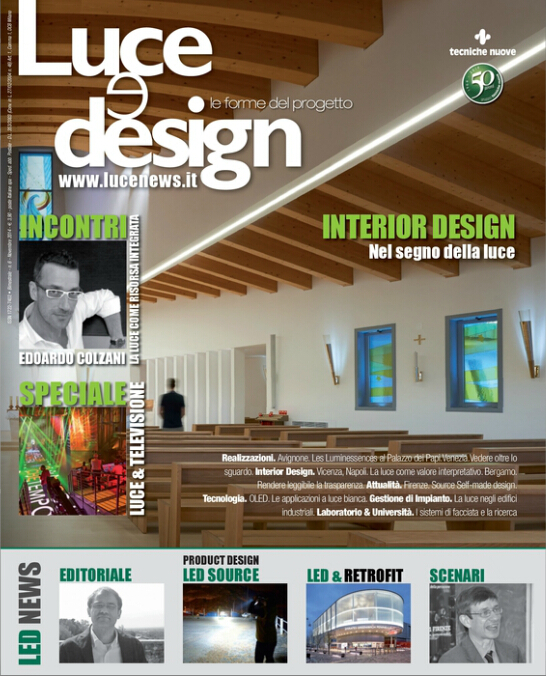对于一些设备/系统,与其他相比,LED的应用不仅多了种选择,而是作为优化系统的核心部分For some installations/systems, the use of LEDs has represented much more than a choice among many others indeed an essential condition for the realization of this system itself end of summary
在圣洛伦索教堂项目中,LED 应用的优势显而易见,很难再找到比此更为合适的解决方案。不过这并不意味着 LED 是符合任何项目的灵丹妙药,然而,但就重点照明领域而言,它本身确实有着不可替代的优势。LED成为重点照明设计方案的最佳选择的关键首先取决于其尺寸方面优势。众所周知,LED 是微型光源,在一些具有视觉挑战性的区域(如隐藏光源等)以及一些局限性的环境中的安装应用中有较强灵活性。
开始阶段的光照条件应注意事项
由雕刻家马里奥·塞罗利设计的位于罗通多港(葡萄牙)的圣洛伦索教堂可谓是建筑界的小巨星。88米宽13米的建堂中殿由数以百计木制雕像以及大理石、玻璃材质的作品装饰,成为该建筑独特的亮点。
光照条件需注意的重点事项:
- 呈现雕塑的价值以及其视觉效果
- 教堂不同时刻所具有的不同功能所需要的照度
针对一个艺术氛围浓厚的环境,其中多选用的照明设备不仅在对艺术品的保护功能方面有着严格的限制性因素,同时,还应考虑该照明设备与被照物整体的和谐一致。
针对该项目而言,最大的亮点是照明点的增加。所有的雕塑都由260个小型投光灯打亮。与之前相比,先前没有被自然光照射的部分,如今通过人工照明得以强调。考虑到雕塑的尺寸,常规的设备安装方式在此更为合适:每一个需要照亮的部位都有一个对应的光源。针对单个或多个雕塑的具体情况,照明设备的光束角宽度、灯具的功率、安装方式也有所不同。光源的分布及灯具的明暗对比增加了建筑的空间感。(如图1)
教堂的观众席部分并没有采用特制的照明系统,而是通过照亮雕塑的漫射光照亮:当光线照射到雕塑上达到最大亮度时,其余光可照亮周边的空间。由于减少了灯具数量,并尽量利用灯具间的相互利用,雕塑被作为光分布的一种元素或一个工具,所以这个方案最终取得了成功。(如图2)。
此外,在雕塑背后安装的光源可营造背光效果,同时,隐藏的照明设备很好地防止了眩光的产生。(如图3)。
安装有双向照明设备的拱形后殿满足了功能及装饰方面的双重需求。主圣坛作为诵读以及弥撒庆祝的特殊空间,由多个投光灯打亮,与打亮壁龛的设备相比,该灯具具有更高的光流量。在祭坛的基座下装有泛光灯打亮了现有的雕塑群(如图4)。
该项目的平均照度约为100lux;在祭坛空间可调为300,针对雕塑时又可调为500。以宗教照明氛围为主线,其照明系统可根据局部或是整体空间的具体情况调整其光照强度,从而改变空间的照明效果。
照明设备的选择
选择此种设备的决定性因素如下:
- 可选择额定光通量并进行调节
- 可调节不同的光束角
- 可调节 LED 色温
- 结构的紧凑性
- 散热效果
LED 产品可通过一下三种途径决定输出的光通量:
- 改变驱动器(电流)
- 改变应用的 LED 数量
- 将以上两种途径结合
通过在一定数量的LED 增加电源电流,输出的光通量会随之增加,同时温度状况也将有一定程度的浮动。在众多情况下,这只是对标准的可变功率的演示(例如,设备从1W到3W)。除了通过高功率满足了热处理的要求,该技术可使设备保留原有的尺寸(如图5)。
在拟定的方案中,大部分 LED 可达700毫安(吸收率达2.5瓦左右)。 考虑到雕塑与照明设备的实际距离约为2.5到3米,用于照亮雕塑的最常见的光束角为25°。通过凸显与嵌入墙面或天花板里的除雕塑的细节部分,一些特定的照明设备也可达350毫安(稍微高于1瓦)。对于后者而言(墙里或是天花板里的雕塑部分),光束角为9°,在不影响背景环境的情况下可凸显出垂直的又高又窄的结构。在应用集中的高层次光学处理方法时,应进行深入研究,以防造成可能性的直射现象。
对一个 LED 系统来说,色温的选择是决定性的因素,因为它会影响到单元输出的光通量、照明效果以及吸收功率。 据大部分的制造商提供的与色温相关的光学数据显示,相对于暖色调的白光 LED 来说,冷色调的白光 LED 释放出更多的光通量。
在此种情况下,照明设备采用暖光时则会更好的凸显木材的质感,色温约为3, 000K,此时光效稍微低一点(如图6)。
灯具的安装位置也非常重要。影响传统泛光角度的因素主要为光学与电器部件。在 LED 设备中,我们还必须考虑用于散热的专业设备的安装位置,其位置通常应靠近二极管。考虑到所应用的光学设备,大部分的设备都采用了透镜与反射器。安装微小 LED 的设备通过二级透镜进行光输出,结合最新的TIF 技术,达到一定规模的LED的照明设备(例如,多片、阵列或模块)能够配备反射器时。无论何种方式,与传统的光源相比,LED的尺寸已减少了不少,甚至光学设备也小了很多。
目前仍为棘手的问题是电器设备需要借助二极管的运作与检测。某些电器设备本身就有电源与管理系统,使得集成产品能够很便捷的安装并更为耐用。另外一种情况,所有的部件都是分开的,这样用户就可以根据制造商提供的电源电压的距离随心所欲的设置设备的位置,同时,还可以从不同的制造商那里购买兼容的产品,寻找符合系统要求的最佳电源。
在提议的安装程序中存在分歧的地方:
- 照明设备(LED、光学器件、散热片)
- DMX 信号控制器
- 电源供应器
该系统的另一优势是借助一些低功率的设备,通过数量优化可将数个照明设备融于一个电器单元中。
在选择系统过程中出现障碍时,对线路以及设备正确定位的分析便变得必不可少。电源与设备必须安装于被保护的区域内,同时运营时的温度无论如何也要在制造商规定的范围之内(如图7)。
群集的定义与控制系统
260个投光灯的任何一个设备都不能凭借本身的光线照亮自己,而是通过彼此合作集中照亮,从而大大简化了系统。群集可分为两种类型:
- 利用功率实现实体群集
- 利用软件实现虚拟群集
实体群集以驱动程序的线路为最小的管理单元:每一个单元对应一个地址(或程序)调光范围从0到100%。但是只有重新布线才能改变独立单元在整体设备中所体现的功能 (如图8)。
虚拟群集则是由实体群组(现在是附属群组)组成,接收控制的相同信息,同时在同一时间做出反应。实体附属群组可设有多种调光模式,以此营造最恰当的着灯光效果。
例如,虚拟群体可包含两个实体的附属小组,可同时打开或关闭。
- 当设备靠近雕塑时为50%
- 远离雕塑时为70%
虚拟组群可随人的意愿进行调节,同时无需实体因素的介入 (如图9)。
电器以及控制系统的分布应遵循的一些设计理念,如:
- 调光范围从1到100%
- 一组设备同时打开
- 某些部件或设备在更多场景中的应用
- 非专业用户对照明的管理
如之前所述,照明设备的独立控制应用在一定程度上可使功率在安装阶段变得更为灵活。复杂的管理需要逻辑性强的电子系统予以配合,因此我们在硬件以及信号的协议方面均选择了DMX512控制器。此种方案对于及时、快速的控制灯光及场景来说最为流行和普遍。
该系统包含大概20个(驱动器),每个有3条 DMX 输出通道,电源为230/24 V,直流电为700毫安。每个分支驱动为系统回路提供有线设备。每个通道可支撑6个700毫安的 LED,电源最高可达50W左右。DMX 驱动之间的输出与输入两端相互连接,从而可以传播信号。每一个通道代表 DMX 的一个可寻地址,并可进行独立操作 (如图10)。
在整体系统的核心领域有一个控制部件,可通过发出的 DMX 信号控制系统的开关。控制组件储存了许多照明场景,可通过一些数字小键盘进行控制,甚至是一些非专业用户也能操作(场景以独立的形式出现)。通过应用专业软件,电脑上这些真实、适当的程序得以呈现。借助电器的群集形式以及其所在的位置的优势,我们可通过软件来模拟照明场景,并在没有系统的地方实施大量的编制程序。在启动程序中,大部分的 DMX 都有动态效应。在终端程序,可以独立控制并储存预定模式,借助简化的键盘为终端用户将其整合。在一些应用领域,也可通过安装在现场的类似控制界面的虚拟键盘进行操作。(图11、12)
The church of San Lorenzo located in Porto Rotondo is a little architectural jewel created by the sculptor Mario Ceroli. The unique nave having dimensions 8 x 13 meters is decorated with hundreds of wooden statues as well as with marble and glass works.
The main points of the lighting conditions are:
● the importance and evaluation of the sculptures;
● the illumination of different moments of the religious function.
In a highly artistically important surrounding, the lighting system is subjected to particularly strict protection restrictions. The strong need to realize a non-invasive system in conjunction with the lighting objectives has been taken into consideration too.
The most outstanding feature in this aspect is the multiplication of the points of light. All the sculptures are illuminated through 260 small projectors; and now, compared to the past, even those parts which previously were not captured by the natural light are now highlighted or better to say brought to the light by the artificial illumination. Considering the dimensions of such structure, which led to the necessity of a scale factor, a conventional installation could be taken into consideration, in which each visual task corresponds to a respective source. Different solutions have been adapted to the beam width, to the power emitted from the lighting body (emitted flux) and geometry of installation all depending on a specific statue or on a group of statues. The fragmentation of the sources and the resulting intensification of parametric contrasts and shadows increase the perceived space (See picture 1).
The auditorium does not have any particularly tailored light system and is feed by the remaining light which is diffused into the surroundings when the illuminance level on the statues is at its maximum intensity. Once again the outcome is successful due to the reduced quantity, where it is possible to exploit every lowest inter-reflection. In this situation the statues have been perceived at the same extent as an element to be exploited and as an instrument to achieve a proper light distribution (See picture 2).
Moreover, the possibility of placing the sources of light at the back of the sculptures has allowed the generation of suggestive backlit games, creation of an entirely glare-free perimetric illumination keeping the devices hidden (See picture 3).
The apse functions with a dual illumination system having both a functional and decorative aim. The main altar, as the selected place for the reading and Mass celebration, is illuminated by various projectors which have a higher flow compared to those dedicated to the niches. A floodlights’ battery located underneath the altarpiece base brings out and highlights the existing sculptural group (See picture 4).
The average illuminance of reference is about 100 lux; it can be raised to 300 in the altar area and reaches its peak of 500 on certain sculptures. The system is built in a way that permits the possible adjustments in intensity in its entirety or for specific areas. This allows the atmosphere change in the existing space and the restitution of the works without affecting the lighting aimed at the religious purposes.
Selecting of lighting stuff/devices
The determining reasons for the selection of the devices include:
● possibility to choose the nominal flow and adjust it;
● possibility to choose between different amplitudes of the light beam;
● possibility to opt for the LED color temperature;
● structure compactness;
● heat dissipation
LED products create the ranges of emitted flow in three ways:
● with the variation of the drive (current);
● with the variation of the number of LED’s in use;
● by combining both the above mentioned variations.
By maintaining invariable/constant the number of diodes and increasing the power supply current, the amount of emitted flow will be increased, but the temperature conditions will also fluctuate. In many catalogs this is demonstrated with an indicative power variation (for example, devices from 1W to 3W). This technique allows maintaining the same size of the device, provided that it should be resized for thermal disposal required by a higher power (See picture 5).
In the proposed project the majority of LED’s run at 700 mA (more or less 2.5 W of absorption). The most commonly opening beam used for the sculptures is 25°, taking into account the existing distance of approximately 2.5 to 3 m between the statue and device. A restricted number of devices run at 350 mA (slightly more than 1 W) by intervening to point out the structural details unrelated to the sculptural solid mass/group situated in the walls and ceiling. For the latter one, the opening of the beam is 9°, which enables to highlight the vertical high and narrow elements without affecting the background surroundings. The use of optical means with a high level of concentration must be accompanied by a thorough study to avoid any possible direct glare phenomena.
The color temperature selection is decisive in a LED system since it affects the amount of light emitted from the unit, as well as on the lighting and the absorbed power. It is proven that the white light LED’s emit more flow in the cool tones and less in warm tones according to the majority of manufacturers given the photometric data which are relative to any color temperature.
In such situation, all devices have a warm tone of light that is particularly suitable to highlight the substantial qualities/features of the wood. The color temperature is about 3000 K, so we can say that it is not particularly advantageous with regard to the efficiency (See picture 6).
The space used by the device is extremely important for some installations. The factors that mostly influence the dimensions of a traditional floodlight are both the optical and electrical components. In LEDs case we must also consider the dedicated devices to thermal dissipation, normally placed close to the diode. With regard to the optical equipments used, most of the devices apply lenses or reflectors. The devices that mount small dimension LEDs drive the flow through secondary lenses, and the most widespread exploit TIF technology, while devices with amalgamations of LED that reach a certain size (for example, multichip, arrays or modules) can be equipped with a reflector. In either way the dimensions of the diode’s emitting surface are so reduced compared to the conventional light sources that, for a mere scale factor, even the optical device is very small.
What may seem as a sort of awkward is the electronic device required for the operation and inspection of the diode. Certain appliances incorporate the power supply and management system in the body, resulting in an integrated product easy to install and generally more durable over time. In other cases, the components are all separate and this enables for distribution in space at someone’s pleasure, while respecting the distances of power supply voltage specified by the manufacturers. In addition, this allows buying compatible products from different manufacturers, seeking the power which is optimal to the system requirements.
This is the case of the proposed installation, where we differ:
● lighting body (LED, optics, heat sink);
● driver DMX signal;
● power supply.
This is quite advantageous for systems with an elevated number of low power absorption devices as it allows combining multiple lighting devices into a one electrical unit, optimizing the number of elements.
When opting for a system breakdown, an increased level of concern in laying the lines and as well the right placement of the equipments is required. Both power suppliers and drivers must be arranged in the protected areas, but the operating temperatures nevertheless need to be within the limits indicated by the manufacturer (See picture 7).
Definition of clustering and control systems
Any of the 260 supplied projectors does not light up on its own but in groups instead, creating a considerable simplification to the system. There are two main categories of clustering:
● physical ones, using the power;
● virtual ones, using the software.
The physical groups conditional on the drivers’ wiring are the minimum manageable unit: they respond to an address (or channel) and can be attuned from 0 to 100% of the nominal flow. It is not possible to change the assignment of a unit to a given group except through the re-wiring procedure (See picture 8).
The virtual teams are combinations of physical groups (now sub- groups) that accept the same message of control and thus react in the same period of time. The physical subgroups can be set with various dimming values so as to create a view with balanced light levels.
To take an example, a virtual grouping can take into consideration two physical subgroups that will switch on and off simultaneously:
● the first regulated at 50% as the appliances are positioned at a close range to the sculptures;
● the second at 70%, as it is positioned at a larger distance
The virtual groups can be modified at someone’s wish in the scheduling point with no physical intervention on the equipment (See picture 9).
The electrical and control system distribution follows the requirements defined by concept, such as:
● adjustment of the flux emitted from the devices from 0 to 100 (rate);
● power on / simultaneous setting of certain devices;
● allocation of some components/devices at additional/more scenes;
● lighting management by unskilled users.
Understanding that the “dismemberment” of the appliance in block as previously described enables a degree of power flexibility during the installation phase, it is obvious that the complexity of management requires a logical digital clustering. The adopted system is the DMX 512 type for both the hardware and the protocol of the signal. Such a solution is among the most widespread for the management of composite light sequences and scenery which require rapid response times.
The system consists of approximately 20 interfaces (driver) DMX 3 channels each, and its power supply 230/24 VDC at 700 mA. From the outputs of the driver branch off the lines supplying the wired devices in series. Each channel supports up to 6 LED 700 mA for a power supply maximum of approximately 50 W. The DMX interfaces are all connected to one another through to outputs in / out and this establishes the circulation of the signal. Each channel is adjusted individually and represents an address in the DMX universe (See picture 10).
At the core basis of the entire system there is a control unit that handles the switching system by sending DMX signals. The control unit has been stored a number of bright scenes that can be addressed through a numeric keypad available even by less specialized user (in standalone modality). The real and proper programming occurs on PC instead through the use of the dedicated software. Keeping in mind the clustering pattern of the appliances and their positioning makes possible to simulate bright scenes using the software and carry out a large part of programming without necessarily being at the system’s site. The majority of DMX software has dynamic effects libraries to build up in a simple way ignition sequences. Upon the program termination, it is entered in standalone mode that enables to store the defined scenes and associates them with a simplified keyboard for the end user. In certain applications it is possible to work on a virtual keyboard similar to the control interface that shall be physically installed on site (See picture 11, 12).


































